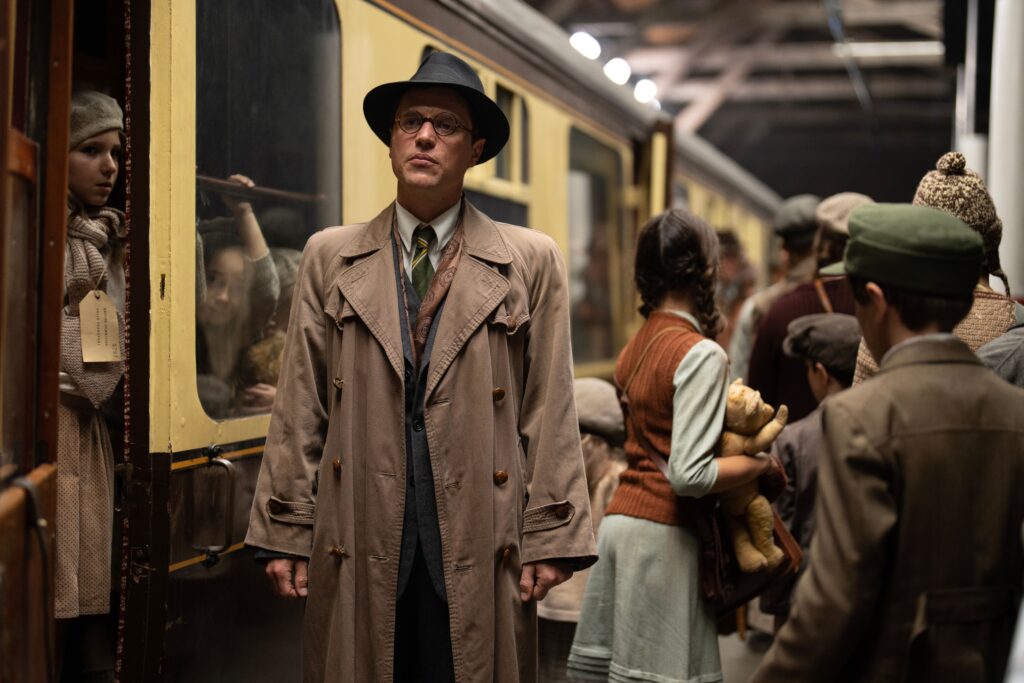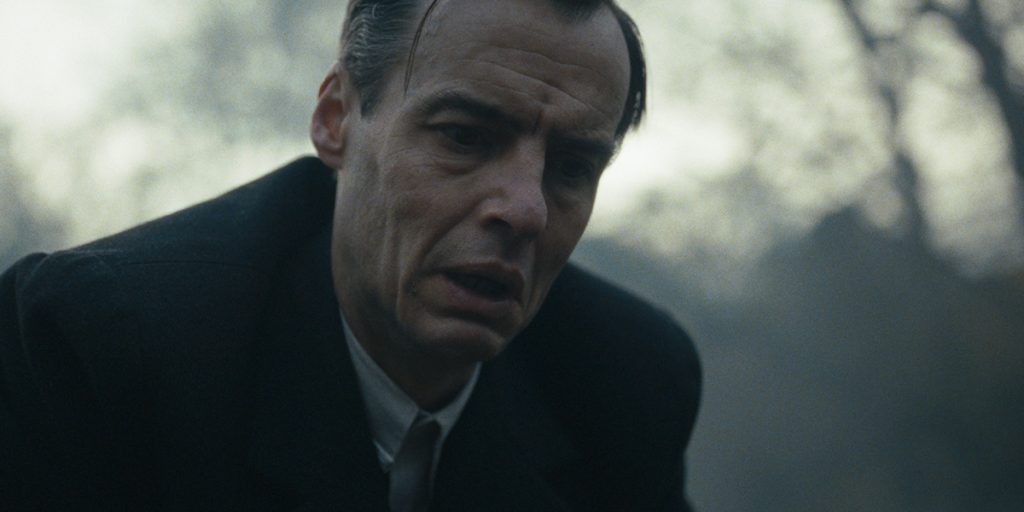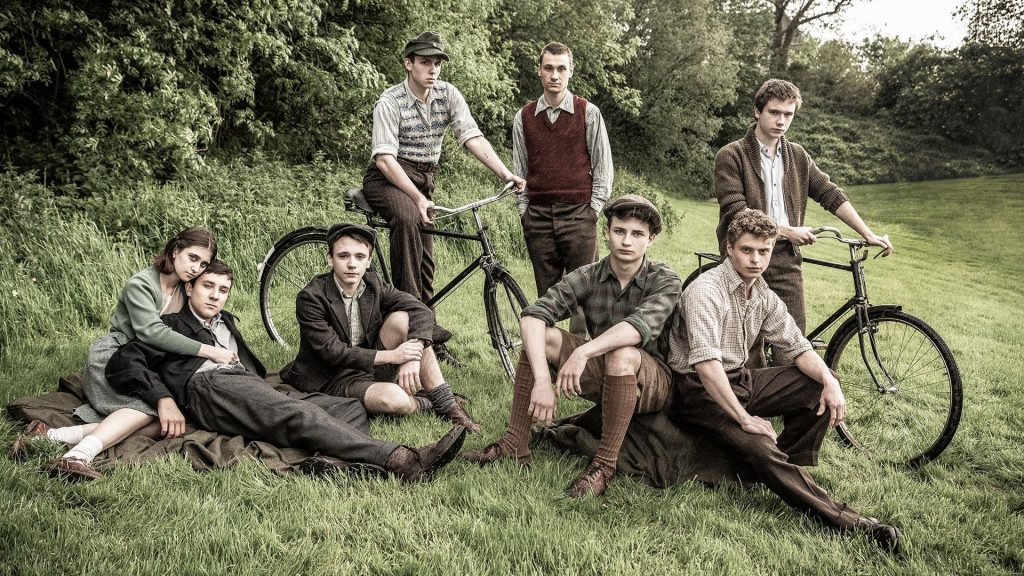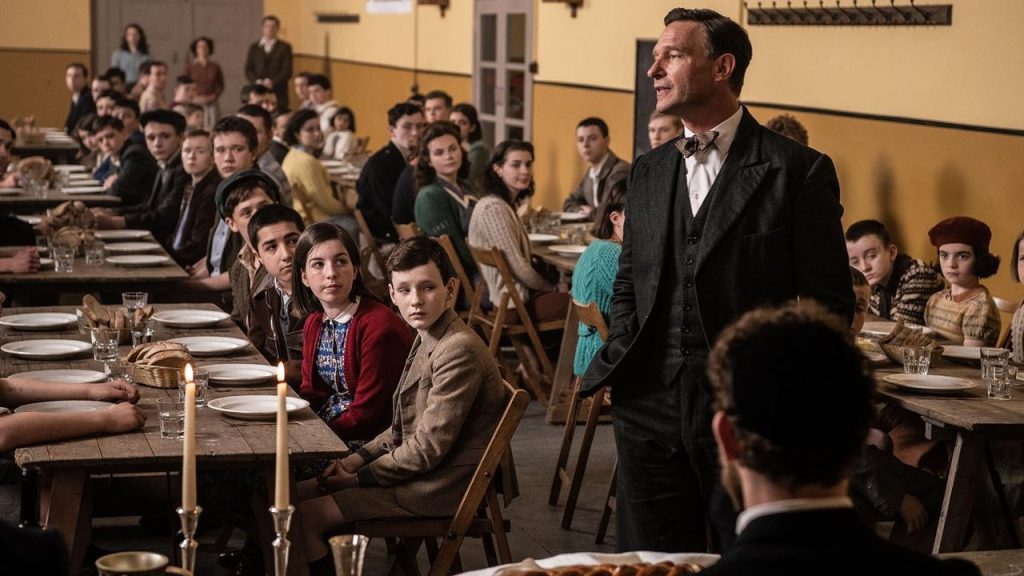March 16, 2024
by Carla Hay

Directed by James Hawes
Culture Representation: Taking place in 1938, 1939, 1987, and 1988, in the United Kingdom, Poland, and the country then known Czechoslovakia, the dramatic film “One Life” (based on the non-fiction book of the same name) features an all-white cast of characters representing the working-class, middle-class and wealthy.
Culture Clash: In 1938 and 1939, British stockbroker Nicholas “Nicky” Winton leads a crusading group of people who rescue 669 Jewish children from an impending Nazi invasion of Czechoslovakia, and he gets recognition for these heroic deeds about 50 years later.
Culture Audience: “One Life” will appeal primarily to people who are fans of star Anthony Hopkins and true stories about rescuing people from the horrors of the Nazi-led Holocaust.

If you can tolerate filmmaking that’s a bit stodgy and old-fashioned, “One Life” is worth a watch for its meaningful true story. Anthony Hopkins is memorable in a film that is often undercut by its messy timeline jumping. The movie needed a more cohesive narrative, but the story is still easy to understand and requires patience to get to the movie’s best parts toward the end of the film.
Directed by James Hawes, “One Life” was written by Lucinda Coxon and Nick Drake. The movie is based on the 2014 non-fiction book “If It’s Not Impossible…: The Life of Sir Nicholas Winton,” which has been retitled “One Life: The True Story of Sir Nicholas Winton,” written by Nicholas “Nicky” Winton’s daughter Barbara Winton, who died in 2022, at the age of 69. “One Life” had its world premiere at the 2023 Toronto International Film Festival. The movie was filmed in the Czech Republic and in the United Kingdom.
“One Life” jumps around in the timeline from 1938 and 1939 to 1987 and 1988. In 1938, Nicky Winton (played by Johnny Flynn) is a 29-year-old stockbroker living in London, when he hears from his friend Martin Blake (played by Ziggy Heath), who has been helping refugees in Prague, Czechoslovakia. The refugees want to escape, as Nazi Germany prepares to invade Czechoslovakia. Just as Nicky was going to join Martin in Prague, Martin has called to tell Nicky that Martin is going back home to London. Nicky plans to go to Prague as planned.
Nicky has a strong-willed and opinionated mother named Babette “Babi” Winton (played by Helena Bonham Carter), a widow who is originally from Germany. The family of Nicky’s father was also originally from Germany. Nicky’s parents have relatives who are Jewish. Nicky identifies as an agnostic and a socialist. Babi doesn’t think it’s a good idea for Nicky to go to Prague, because she fears that his life will be in danger. Nicky can be just as stubborn as his mother, so he goes to Prague, despite her objections.
While in Prague, Nicky meets two British people who will change his life: Trevor Chadwick (played by Alex Sharp) and Doreen Warriner (played by Romola Garai), who both work for the British Committee for Refugees in Czechoslovakia. Doreen tells Trevor that she first came to Prague 10 years earlier for a university study trip. She returned to Prague because of her love of Prague’s people. Nicky, Travor and Doreen decide to what they can to help as many children (with permission from their parents) relocate to the United Kingdom and be placed in foster homes until it’s safe for them to come back to Prague.
When they tally up the numbers, there are more than 1,000 children who could potentially be rescued. Although the vast majority of the children are Jewish, Nicky says he wants to rescue children of any or no religion. In a race against time, Nicky and his allies have to not only find enough funding for these relocations, but they also have to find enough families in the United Kingdom who will be willing to be foster families. Nicky says these foster families can be of any religion.
Many of the potential foster parents have specific requirements, such as only wanting a child of a certain gender and only being able to take care of one child. An unfortunate reality was that many siblings were separated, in order to be placed in foster homes that could take a limited number of children. And an even harsher reality was that many of the children’s parents and other loved ones would be murdered in the Holocaust.
Nicky eventually returns to London to raise money and awareness (with the help of his mother) for these child refugees. He faces an uphill battle, since many British people at the time did not want to get involved in Eastern European politics. Nicky also gets some skepticism about his intentions from Jewish leaders in Czechoslovakia and in the United Kingdom, until Nicky makes it known that he has Jewish heritage. The rescue mission, which is called Kindertransport, ends up saving 669 children.
“One Life” shows these rescue efforts in a perfunctory manner, often in montages. These scenes are intercut with elderly Nicky (played by Hopkins) in 1987 and 1988, when he is living in suburban Maidenhead, England. Senior citizen Nicky is finding some of his Kindertransport mementos and records while he is cleaning up his cluttered study. The reason for the cleanup is that Nicky’s wife Grete Winton (played by Lena Olin) has been complaining that Nicky’s mementos and records have been taking up too much space in their home, and they need room for an upcoming visit from their pregnant daughter.
Nicky was an amateur photographer who took a lot of photos of the children he rescued, as well as their Czech neighborhoods. He kept these photos, as well as meticulous records of the refugees, without knowing what happened to them. His wife Grete tells Nicky about these memories that haunt him, “You have to let go, for your own sake,” but Nicky can’t really let go. Going through these photos and records of these refugees bring these memories back to him.
Jonathan Pryce has a small role as the elderly Martin Blake, who meets Nicky for lunch and comments to him about Nicky’s Kindertransport rescue efforts in the late 1930s: “It’s incredible what you achieved.” (It’s an on-screen reunion of Prye and Hopkins, who both starred in 2019’s “The Two Popes.”) Nicky humbly says that Trevor and Doreen took more of the risks in the rescue efforts, because they stayed in Prague. “One Life” doesn’t really extend that acknowledgement, because the rest of the movie is all about Nicky getting recognition for this rescue mission.
It all starts when Nicky gets a call from a library in England saying that they’re interested in the archives that he wants to donate. At his wife’s urging, Nicky decided that these records were better off in an official institution instead of in their home. When he meets with Holocaust researcher Elisabeth “Betty” Maxwell (played by Marthe Keller), she is amazed at Nicky’s collection and says that it’s too big and important for a library and should belong in a museum.
And what do you know: Betty just happens to be married to Robert Maxwell, the Czech-born British media mogul who owned the Mirror Group Newspapers at the time and who got the publicity machine going to tell Nicky’s story. The movie doesn’t mention the later scandals associated with Robert Maxwell (who died at age 68 from a boating accident in 1991), including his history of fraud and the fact that his socialite daughter Ghislaine Maxwell became a convicted sex offender due to her relationship with Jeffrey Epstein. The publicity over Nicky’s Kindertransport archival collection results in him getting invited on the BBC talk show “That’s Life!,” which leads to the most tearjerking parts of the movie.
“One Life” is certainly an inspirational story. However, the movie could have been a little bit more gracious in showing that happened to Trevor and Doreen, instead of reducing them to brief updates in the movie’s epilogue. Hopkins and Bonham Carter give very good performances, but there’s nothing award-worthy about this movie, which has a formulaic style and at times a manner that is too plodding. The movie is called “One Life,” but the real lives from this story are at the heart of the movie and what viewers will be thinking about the most.
Bleecker Street released “One Life” in select U.S. cinemas on March 15, 2024. The movie was released in Italy and in Australia in December 2023.






